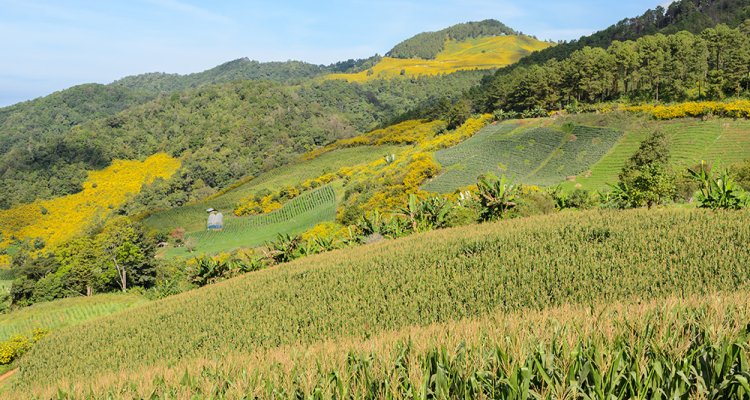
Ecosystem services provided by soils in a Mexican agro-forest landscape
Tropical agro-forest landscapes are dynamic mosaics of natural vegetation, semi-natural habitats, and farming systems, that provide essential ecosystem services (ES), benefits that people obtain from ecosystems. ES are co-produced in social-ecological systems, which imply the active role and influence of management decisions and practices on ecosystem processes.
Thus, land use intensification affects a range of ecosystem processes and services with a potential disconnect between supporting and regulating services which form the basis for provisioning services in systems with little external inputs. I investigated the ES provided by soils in a landscape consisting of (managed) forests, rangelands and croplands with a special focus on the effect of land use intensification on the forest – rangeland frontier. I carried out my research in La Sepultura Biosphere Reserve, located in Chiapas, Mexico, specifically in two communities or ejidos. Through a general soil characterisation in both ejidos and interviews on cattle management practices with farmers, I evaluated the impact of landscape and land use on supporting and forage-provisioning ES and their linkages. Then, I assessed land use intensification on the soil system and litter decomposition through a decomposition field experiment.
New alternative intensification pathways should be sought to maintain landscape multifunctionality by reducing negative effects of land use intensification and enhancing positive effects on different components in a managed system.
Finally, I investigated the effects of land use intensification on above and belowground components (plants, soil fertility, and soil microbiota). I evaluated whether and how these above and belowground components of the plant – soil feedback were linked. Results showed that indirect effects of land use (through some soil physicochemical characteristics) were more important than direct effects on supporting ES. Linkages between supporting and forage-provisioning ES were complex associations, sometimes with unexpected trade-offs. Although land use intensification contributed to differences in soil microbial characteristics, it had little cascading effects on litter decomposition as differences in litter quality of the two dominant litter types in this rangeland system were the main factor regulating decomposition.
Furthermore, land use intensification had both positive and negative effects on different attributes of the plant – soil feedback in this ecosystem. The three components of the plant – soil feedback were partly coupled and plants had the strongest effect in the plant – soil feedback and, in turn, vegetation productivity was positively influenced by nutrient availability and soil microbiota. With these results I address the question: Does land use intensification inevitably have mostly negative impacts on the soil system and ecosystem processes? Many studies suggested that land use intensification leads to a decline of soil quality indicators and a loss of functional diversity, whereas other studies emphasised a trade-off between increasing short-term productivity versus maintaining long-term sustainability.
I argue that alternative pathways leading to more efficient systems are needed. Ecological intensification, which is defined as a process that improves performance of managed systems through optimal management of their ecological functions and biodiversity, while providing farmers’ livelihoods, may be one of such alternative pathways. I recommend general practices of ecological intensification at the landscape level to improve overall soil quality and plant nutrient uptake and to support increasing water-holding capacity, which is a key ES, especially during the dry season.